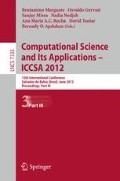Abstract
Satellite time series offer great potential for a quantitative assessment of urban expansion, urban sprawl and for monitoring of land use changes and soil consumption. This study deals with the spatial characterization of expansion of urban areas by using spatial autocorrelation techniques applied to multi-date Thematic Mapper (TM) satellite images. The investigation focused on several very small towns close to Bari. Urban areas were extracted from NASA Landsat images acquired in 1976, 1999 and 2009, respectively. To cope with the fact that small changes have to be captured and extracted from TM multi-temporal data sets, we adopted the use of spectral indices to emphasize occurring changes, and spatial autocorrelation techniques to reveal spatial patterns. Urban areas were analyzed using both global and local autocorrelation indexes. This approach enables the characterization of pattern features of urban area expansion and it improves land use change estimation. The obtained results showed a significant urban expansion coupled with an increase of irregularity degree of border modifications from 1976 to 2009.
Access this chapter
Tax calculation will be finalised at checkout
Purchases are for personal use only
Preview
Unable to display preview. Download preview PDF.
References
Anselin, L.: Local indicators of spatial association – LISA. Geographical Analysis 27, 93–115 (1995)
Benguigui, B., Chamanski, D., Marinov, M.: When and where is a city fractal? Environ. Planning B 27, 507–519 (2000)
Boots, B.N., Getis, A.: Point Pattern Analysis. Sage Publications, Newbury Park (1988)
Cheng, J., Masser, I.: Modelling urban growth patterns: a multiscale perspective (2002)
Danese, M., Lazzari, M., Murgante, B.: Kernel Density Estimation Methods for a Geostatistical Approach in Seismic Risk Analysis: The Case Study of Potenza Hilltop Town (Southern Italy). In: Gervasi, O., Murgante, B., Laganà, A., Taniar, D., Mun, Y., Gavrilova, M.L. (eds.) ICCSA 2008, Part I. LNCS, vol. 5072, pp. 415–429. Springer, Heidelberg (2008), doi:10.1007/978-3-540-69839-5_31.
Frankhauser, P.: The Fractal Approach, a new tool for the spatial analysis of urban agglomerations, Population: An English Selection. New Methodological Approaches in the Social Sciences 10(1), 205–240 (1998)
Geary, R.: The contiguity ratio and statistical mapping. The Incorporated Statistician (5) (1954)
Getis, A., Ord, J.: The analysis of spatial association by distance statistics. Geographical Analysis 24, 189–206 (1992)
Green, K., Kempka, D., Lackey, L.: Using remote sensing to detect and monitor land cove and land use. Photogrammetric Engineering and Remote Sensing 60, 331–337 (1994)
Howarth, J.P., Wickware, G.M.: Procedure for change detection using Landsat digital data. International Journal of Remote Sensing 2, 277–291 (1981)
Lacy, R.: South Carolina finds economical way to update digital road data. GIS World 5(10), 58–60 (1992)
Lambin, E.F.: Change detection at multiple scales seasonal and annual variations in landscape variables. Photogrammetric Engineering and Remote Sensing 62, 931–938 (1996)
Lanorte, A., Danese, M., Lasaponara, R., Murgante, B.: Multiscale mapping of burn area and severity using multisensor satellite data and spatial autocorrelation analysis. International Journal of Applied Earth Observation and Geoinformation (2012), doi:10.1016/j.jag.2011.09.005
Lichtenegger, J.: ERS-I: land use mapping and crop monitoring: a first close look to SAR data. Earth Observation Quarterly, 37–38 (May-June 1992)
Light, D.: The national aerial photography program as a geographic information system resource. Photogrammetric Engineering and Remote Sensing 59, 61–65 (1993)
Masek, J.G., Lindsay, F.E., Goward, S.N.: Dynamics of urban growth in the Washington DC metropolitan area, 1973-1996, from Landsat observations. Int. J. Rem. Sensing 21, 3472–3486 (2000)
Moran, P.: The interpretation of statistical maps. Journal of the Royal Statistical Society (10) (1948)
Muchoney, D.M., Haack, B.N.: Change detection for monitoring forest defoliation. Photogrammetric Engineering and Remote Sensing 60, 1243–1314 (1994)
Murgante, B., Danese, M.: “Urban versus Rural: the decrease of agricultural areas and the development of urban zones analyzed with spatial statistics” Special Issue on Environmental and agricultural data processing for water and territory management. International Journal of Agricultural and Environmental Information Systems (IJAEIS) 2(2), 16–28 (2011) ISSN 1947-3192, doi:10.4018/jaeis.2011070102
Nelson, R.F.: Detecting forest canopy change due to insect activity using land sat MSS. Photogrammetric Engineering and Remote Sensing 49, 1303–1314 (1983)
Sailer, C.T., Eason, E.L.E., Brickey, J.L.: Operational multispectral information extraction: the DLPO image interpretation program. Photogrammetric Engineering and Remote Sensing 63, 129–136 (1997)
Shen, G.: Fractal dimension and fractal growth of urbanized areas. Int. J. Geogr. Inf. Sci. 16, 419–437 (2002)
Tateishi, R., Kajiwara, K.: Global Lands Cover Monitoring by NOAA NDVI Data. In: Proceeding of International Workshop of Environmental Monitoring from Space, Taejon, Korea, pp. 37–48 (1991)
Tobler, W.R.: A computer movie simulating urban growth in the Detroit region. Economic Geography 46(2), 234–240 (1970)
United Nations Population Division (2001) World Population Monitoring 2001: Population, environment and development (2001), http://www.un.org/esa/population/publications/wpm/wpm2001.pdf
Yang, X., Lo, C.P.: Using a time series of satellite imagery to detect land use and land cover changes in the Atlanta, Georgia metropolitan area. Int. J. Rem. Sensing 23, 1775–1798 (2002)
Yuan, F., Sawaya, K., Loeffelholz, B.C., Bauer, M.E.: Land cover classification and change analysis of the Twin Cities (Minnesota) Metropolitan Area by multitemporal Landsat remote sensing. Rem. Sensing Environ. 98, 317–328 (2005)
Author information
Authors and Affiliations
Editor information
Editors and Affiliations
Rights and permissions
Copyright information
© 2012 Springer-Verlag Berlin Heidelberg
About this paper
Cite this paper
Nolè, G., Danese, M., Murgante, B., Lasaponara, R., Lanorte, A. (2012). Using Spatial Autocorrelation Techniques and Multi-temporal Satellite Data for Analyzing Urban Sprawl. In: Murgante, B., et al. Computational Science and Its Applications – ICCSA 2012. ICCSA 2012. Lecture Notes in Computer Science, vol 7335. Springer, Berlin, Heidelberg. https://doi.org/10.1007/978-3-642-31137-6_39
Download citation
DOI: https://doi.org/10.1007/978-3-642-31137-6_39
Publisher Name: Springer, Berlin, Heidelberg
Print ISBN: 978-3-642-31136-9
Online ISBN: 978-3-642-31137-6
eBook Packages: Computer ScienceComputer Science (R0)

